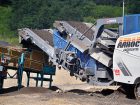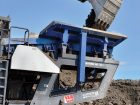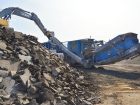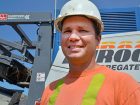
Features
Aggregates
Profiles
Stockpile Management
New crushing equipment helps AAROC manage its stockpiles
June 9, 2015 By Tom Kuennen
A new impact crusher is keeping a western Ontario aggregates producer in the black as it processes 1-in.-minus reclaimed asphalt pavement (RAP) particles from chunks as big as a coffee table, with the help of the right excavator.
The processed RAP – originating from driveways and parking lots, in addition to cold milling machines – is destined for use as fill and for top dressings for low-volume pavements and parking lots. Asphalt millings from pavements are kept separately for use in spec asphalt mixes for local road agencies.
“The biggest challenge we have is uncertainty and variability of the product in our production environment,” said Jamie Martelle, sales and operations manager, AAROC Aggregates. “Not every site is the same. Not all feed materials are the same. One of the reasons we chose this mobile crusher was its versatility in being able to adapt to site conditions. For example, we get positive production in tight quarters.”
To maintain consistency of end product, AAROC separates incoming asphalt from commercial projects from incoming highway pavements. “Asphalt is softer than concrete, so it doesn’t take much to break it down,” Martelle said. “Nonetheless we will get better production from asphalt milled product than slab product. That’s why we control the raw material as it comes in; we know the customers and what they provide. As long as we have the room to keep the stockpiles separate we can maintain composition.”
Depending on location, in addition to the 1-in.-minus RAP, AAROC will produce a 5/8-in.-minus RAP for incorporation into spec asphalt mixes.
AAROC moves the crusher from pit to pit, or quarry, but has the option to move it to construction sites where demolition concrete or asphalt exists to be recycled. RAP was being processed at Westcliff Pit, one of five locations in Ontario managed by AAROC Aggregates, a unit of the John Aarts Group of Ilderton, Ont., which also includes J-AAR Excavating and AAROC Equipment.
AAROC was crushing RAP pieces at a rate of 300 to 325 metric tonnes (330 to 358 short tons) per hour, said AAROC’s crusher foreman Tom Ritchie. “That’s an adequate speed,” he said. “Anything more than that will make it hard to keep up with the excavator, or you are having to watch the belt.”
One challenge AAROC met in searching for a new crusher was using the right excavator to feed raw material.
AAROC has had its new Kleemann Mobirex MR 130 ZS EVO impactor with 52-in. crusher inlet width since January 2014, but first tested the waters with a MR 110 ZS EVO with 44-in. crusher inlet width.
“We fed the MR 110 with a smaller excavator,” Ritchie said. “We started off with MR 130 using a like-sized excavator, but we were struggling to keep up with the asphalt.”
Breakout force was lacking, he said. “We were alright with recycling concrete, but with the asphalt we needed more ripping power to get through the asphalt. The reclaimed asphalt will get packed in hard, as it melds together in the sun,” Ritchie said. “Trucks back over it and the excavator runs over it too.” AAROC now is feeding the MR 130 ZS EVO with a 2.75 cu. yd. bucket, 54-in. wide.
Prescreen for Productivity
An integral, double-deck, independent prescreen below the receiving hopper improves RAP productivity and profitability for AAROC. The denotation “Z” in the nomenclature of the Kleemann MR 130 ZS EVO indicates the presence of this prescreen, which utilizes an elliptical motion instead of vibratory linear motion.
The benefit is more product coming out of the prescreen much cleaner, with smaller material bypassing the crushing circuit or going to the side belt as a saleable product, increasing total output and reducing long-term wear costs.
“It lessens the load on the crusher itself,” Ritchie said. “It lets the fines pass through so they are not fed into the crusher, causing needless wear. It lightens the load overall. The fines drop through, join the crushed material where they are sized in the attached final screen, and oversize is returned to the crusher circuit.”
With its Continuous Feed System (CFS), each step the material goes through in AAROC’s plant is wider than the width of the one before it, eliminating choke or wear points.
The crusher is diesel direct-driven via a fluid coupler, and feedback is provided from the engine to the controlling computer, allowing indications that the crusher may be getting overloaded. CFS manages a more equal loading of the crushing area, in which the conveying frequencies of the feeder trough and the prescreen are adapted independently of each other to the level of the crusher, thus significantly boosting performance.
“It lets the system know when it’s getting overloaded, and will slow down the feed so it doesn’t stall the crusher out,” Ritchie said. “It’s a very valuable feature that saves us a lot of digging!”
At the same time the exclusive CFS maintains a choke feed to the crusher, eliminating stops and starts of the feed system, improving production, material shape and wear.
Staying Mobile
The MR 130 ZS EVO impactor from Kleemann is the largest crusher AAROC could obtain that still would fit on its flatbed trailers.
“Our machine is completely portable,” Ritchie said. “We move it as we need it around our pit locations. Any of them may have a need to crush concrete or asphalt, or a customer may request us to come and crush.”
Moving the crusher is the easy part, Ritchie said. “The worst part is cleaning it off. We take any stones off the machine and wipe it down, getting it as clean as we can.”
This contrasts with the existing plant it replaced, a primary crusher with screen alongside, which would recirculate the oversize back to the primary crusher. However, on the new plant, the screen is self-contained, attached to the loading conveyor, and completely eliminates the stand-alone screen.
“The attached final screen was a major factor in our selection,” Martelle said. “No matter what we are doing, every second we run that machine we are saving money.”
“The new impactor works in a much smaller footprint than what we had,” Ritchie said. “It’s a lot easier to set up. With the old plant of crusher and screen it would take three days to tear down and move, with a lot of labour. But with this model we can have it broken down and cleaned in four to five hours, and that’s from the time you stop feeding it to the time your are ready to loading on the low-boy.”
By contrast, the new mobile impact crusher with attached final screen is moved easily, loaded in a couple of hours. “It’s the biggest screen we could get that would fit on our lowboy and still allow us to move it around,” Ritchie said. “That’s due to weight restrictions, height and width. The final screen stays on, but we have to lower the side conveyor and fold the hydraulic hopper sides down, which is easy to do. You can’t beat it.”
With the new plant, AAROC also is accruing significant savings in fuel consumption. “We’re seeing a 30 to 35 per cent reduction in fuel costs with the new impact crusher,” Martelle said. “It has much to do with the diesel-electric direct drive, as opposed to a hydraulic drive.”
Ritchie’s hand-held remote control allows him to operate the crusher from within the feeding excavator cab, or control its movement as he walks alongside it, guiding the impact crusher onto the flatbed trailer. “We just track it up and on like any other tracked piece of equipment,” Ritchie said.
“The remote controls feeder speed, magnet belt, and the tracks,” he said. “It also will raise and lower the jam door on top of the apron lid. If you get a big piece in the hopper, or it’s standing upright and won’t go in, you can raise the door and keep the flow going.” With the magnet belt, if a large piece of steel comes out, the belt can be raised for access, Ritchie added.
The versatility and quickness of mobilization of the machine has allowed us to service all our various locations’ market demand,” Martelle said. “If we had our old set up, we would be well behind on our production targets, due just to lost time of mobilization. Because we can move the Kleemann in the morning and be running it in the same day, across town or 50km away, we can crush another day and a half more than we could before.”
“They say ‘If you like what you are doing, it ain’t work.’” With the opportunity to control a powerful crusher via remote, and to dig piles of aggregate, Ritchie likes what he is doing. “It’s every little boy’s dream to play in the sandbox all day,” he said. “And now I have the biggest remote control of all.”
Print this page



